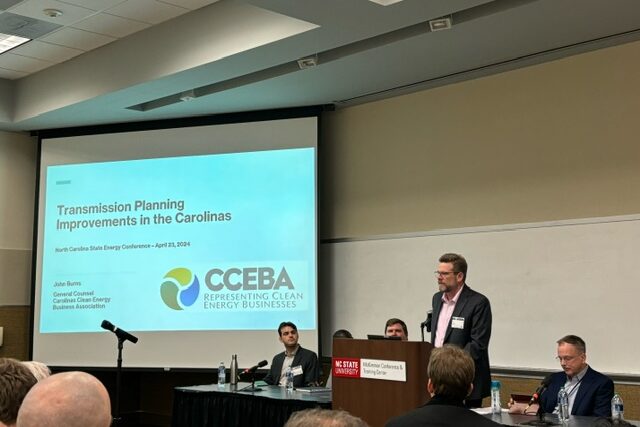
Energy demand is rapidly increasing, and the need for more resilient, reliable energy is placing pressure on an aging grid. This was a hot topic at this year’s North Carolina State Energy Conference, where CCEBA’s General Counsel John Burns spoke on the panel Connecting to the Grid: How Do We Build Out North Carolina’s Transmission System?” John was joined by Jesse Schneider from the U.S. Department of Energy, Ted Kelly of the Environmental Defense Fund, Sammy Roberts of Duke Energy, and Waheed Oyekanmi from TotalEnergies. Catherine Reed of the National Association of State Energy Officials moderated the session.
Transmission in North Carolina
Like the rest of the country, North Carolina’s transmission system was not designed to deliver power from multiple sites to multiple loads. This factor poses a significant challenge to development of renewable energy resources. As the state moves away from coal as a resource and Duke Energy closes its facilities, solar and storage are moving to fill the generation gap. However, the costs of upgrading transmission infrastructure and the congested list of needs is slowing deployment.
As part of the session, John discussed the transmission “Red Zone” in Southeastern North Carolina and Northern South Carolina. The Red Zone has high solar viability, with large tracts of land and farmers who wish to convert their land to diversify income. But the transmission systems in those regions are insufficient to enable development, and over the years many projects bidding into a procurement process for those areas dropped out due to high costs.
The North Carolina Carbon Plan begins to address this issue. Duke Energy is required under the order to construct fourteen Red Zone expansion projects (RZEP) and make reasonable efforts to improve local transmission planning and procedural transparency. There have already been a number of RZEP expansions since its inception; John noted that dramatic load forecast increases foresee nine to twelve GW of solar planned over the next decade, and there is now a RZEP 2.0 and likely incoming 3.0 plan to account for the new capacity.
Carolinas Transmission Planning Collaborative
In 2005, Duke Energy Carolinas, Duke Energy Progress, the ElectriCities, and the North Carolina Electric Membership Corporation formed the North Carolina Transmission Planning Collaborative. This group covered service areas in both North and South Carolina and set up Duke Energy’s open access transmission tariff (OATT).
In March 2024, FERC approved a name change and the group became Carolinas Transmission Planning Collaborative to account for its full membership. This change also involved developing a new schedule for the Transmission Advisory Group (TAG) stakeholder meeting process, in which CCEBA is a participant. John discussed how the TAG process will help drive more proactive, iterative transmission planning and put the southeast region ahead of the curve on upgrade progress. TAG can request studies to help develop new policies, and sets up more consistent meetings to determine base cases, needs, solutions, and reporting.
Overall, the new changes to the Carolinas Transmission Planning Collaborative will allow for a consistent feedback loop of open information between stakeholders and working groups. Strategic transmission will now be reviewed at least once every three years, and there is a concrete set of pathways to study local projects:
- Reliability basis (studies necessary for reliability and compliance)
- Economic basis (projects which increases transmission access based on TAG requests)
- Public policy basis (satisfying public policy requirements, such as Carbon Plan mandates)
- Multi-value strategic transmission (integrating new generation and benefits at least-cost, “at least triennially”)
These forward-looking options account for the multiple benefits of upgraded transmission, taking a holistic approach and allowing for meaningful stakeholder input. Carolinas CEBA is committed to exploring the most economic balance between new generation and transmission upgrades.

Recent Comments